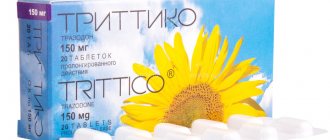Atypical neuroleptic. Synonyms for clozapine: azaleptin, leponex, alemoxan, clazaril, iprox. In our country it is sold in two forms: azaleptin and leponex.
Clozapine
- one of the most powerful antipsychotics available today. It is included in the list of potent psychotropic drugs and therefore its circulation is especially controlled by the state (illegal trafficking may result in criminal liability).
In hospitals it is subject to special control and recording. It is prescribed to patients on special forms of strict accounting on numbered prescriptions of a special form: 148-1/u-88. Of all the antipsychotics, only two drugs have such enhanced control over their distribution and use: clozapine and levomepromazine (tisercin).
It was synthesized back in the 60s of the 20th century, the first experience of its use was in 1971, but it became widely used only in 1990. He is considered the founder of the second generation of antipsychotic drugs - atypical antipsychotics.
Unlike first-generation drugs, clozapine is able to influence negative symptoms (apathy, passivity, decreased emotions, withdrawal) and is noticeably less likely to cause extrapyramidal disorders.
Later, new antipsychotic drugs appeared and continue to appear, some of them are falling out of use, but clozapine is still widely used throughout the world as one of the most powerful antipsychotic drugs.
The mechanism of action is complex: it blocks dopamine (especially D-4) receptors in the brain. In addition, it has a similar effect on acetylcholine, adrenaline, histamine, GABA and serotonin receptors. Due to this, a strong sedative effect is achieved, excitement, impulsivity, and fear are relieved, and productive symptoms of psychosis (delusions, hallucinations) are reduced.
One of the intermediate products of clozapine metabolism is benzodiazepine, the active ingredient of many tranquilizers, which determines the anti-anxiety and hypnotic effects. In some cases, an antidepressant effect may also be observed.
Description of the drug AZALEPTIN
When used simultaneously with drugs that have a depressant effect on the central nervous system (including benzodiazepine derivatives), ethanol-containing drugs, ethanol, the severity and frequency of manifestations of the inhibitory effect on the central nervous system and increased depression of the respiratory center increase.
When used simultaneously with drugs that cause arterial hypotension, additive hypotensive effects are possible.
When used simultaneously with drugs that cause myelosuppression, the inhibitory effect on bone marrow hematopoiesis may be enhanced; with anticholinergic drugs - the anticholinergic effect may be enhanced.
When used simultaneously with digoxin or with drugs characterized by high protein binding (including heparin, warfarin, phenytoin), their concentrations in the blood plasma may increase, and clozapine may also be displaced by these drugs from the sites of its protein binding.
When used simultaneously with valproic acid, a change in the concentration of clozapine in the blood plasma is possible, while clinical manifestations of the interaction were practically absent.
When used simultaneously with carbamazepine, the concentration of clozapine in the blood plasma decreases. Cases of severe pancytopenia and neuroleptic malignant syndrome have been described.
When used simultaneously with caffeine, the concentration of clozapine in the blood plasma increases and the incidence of side effects may increase.
When used simultaneously with lithium carbonate, myoclonus, convulsions, neuroleptic malignant syndrome, delirium, and psychosis are possible.
When used simultaneously with risperidone, an increase in the concentration of clozapine in the blood plasma is possible, apparently due to a competitive effect on the CYP2D6 isoenzyme, which leads to inhibition of the metabolism of clozapine. When quickly replacing clozapine with risperidone, dystonia may develop.
Rifampicin may increase the rate of metabolism of clozapine by inducing the isoenzymes CYP1A2 and CYP3A.
When used simultaneously with phenytoin, a decrease in the concentration of clozapine in the blood plasma is possible; with fluoxetine, paroxetine, sertraline, fluvoxamine, it is possible to increase the concentration of clozapine in the blood plasma, which in some patients is accompanied by toxicity. This effect is especially pronounced when clozapine is used concomitantly with fluvoxamine.
When used simultaneously with ciprofloxacin, it is possible to increase the concentration of clozapine in the blood plasma.
Indications for taking clozapine
- Psychosis with no effect from taking other antipsychotics.
- Schizophrenia
- Organic schizophrenia-like disorder
- Manic psychosis.
- Psychomotor agitation.
- Aggressiveness.
- Severe forms of insomnia.
- Personality disorders (psychopathy), decompensation.
- Derealization and depersonalization in depression.
- Suicidal behavior
The therapeutic effect develops gradually. Relief from agitation, aggressiveness and insomnia occurs within the first 24 hours. Antidelusional, antimanic and antipsychotic effect - within a month.
In a healthy person, taking clozapine can cause a state of indifference and apathy.
Azaleptin, 50 pcs., 25 mg, tablets
Inside.
The drug Azaleptin® should be used only if, before treatment, the number of leukocytes and the absolute number of neutrophils are within normal limits, i.e. leukocyte count ≥3.5·109/l, and absolute neutrophil count ≥2·109/l. In addition, when using the drug, it is necessary to be able to regularly determine the number of leukocytes and the absolute number of neutrophils: weekly for the first 18 weeks, then at least once every 4 weeks throughout the course of treatment, as well as 4 weeks after the end of treatment.
The dose of the drug should be selected individually. The minimum effective dose should be used in each patient. In order to minimize the risk of hypotension, seizures and sedation, the dose should be selected with caution, dividing the daily dose into several doses.
In patients receiving medications that interact with Azaleptin® (such as benzodiazepines or SSRIs), adequate dose adjustment of the drug is necessary.
Transition from previous treatment with antipsychotics to therapy with Azaleptin®.
It is not recommended to use Azaleptin® in combination with other antipsychotics. In the event that treatment with Azaleptin® needs to be started in a patient already taking an antipsychotic by mouth, the dose reduction or discontinuation of the previous drug should be done gradually. Based on clinical data, the attending physician should determine the need to discontinue taking another antipsychotic before starting therapy with Azaleptin®.
Recommended doses
Treatment-resistant schizophrenia
On the first day, use 1 tablet. 25 mg 1 time per day. If it is necessary to start treatment with a dosage of 12.5 mg (1/2 tablet of 25 mg) 1 or 2 times a day, scored tablets containing clozapine 25 mg should be used for dosing accuracy; on the second day - 1 or 2 tablets. drug 25 mg. Subsequently, if well tolerated, the dose of the drug can be slowly increased by 25–50 mg so that within 2–3 weeks a daily dose of no more than 300 mg is reached. Then, if necessary, the daily dose can be increased by 50-100 mg every 3-4 days or, preferably, every 7 days.
In most patients, the onset of the antipsychotic effect of the drug should be expected when using a daily dose of Azaleptin® 300–450 mg (in several doses). Some patients may benefit from a lower dose; others may require doses up to 600 mg/day. The daily dose can be divided into separate doses unevenly, taking most of it before bedtime.
To achieve the full therapeutic effect, some patients require a higher dose of the drug. In this case, it is advisable to gradually increase the dose (by no more than 100 mg each time) until a maximum dose of 900 mg/day is reached. The possibility of a more frequent development of side effects (in particular, the appearance of seizures) should be taken into account when using a dose exceeding 450 mg / day.
After achieving the maximum therapeutic effect, lower maintenance doses may be used. The dose of the drug should be reduced slowly and with caution. Maintenance treatment should continue for at least 6 months. If the daily dose of the drug does not exceed 200 mg, you can switch to a single evening dose of the drug.
Termination of therapy.
In case of planned discontinuation of drug treatment, a gradual dose reduction over 1–2 weeks is recommended. If it is necessary to suddenly discontinue the drug (for example, in the case of the development of leukopenia), the patient should be closely monitored due to a possible exacerbation of psychotic symptoms and the development of withdrawal syndrome associated with the cessation of the anticholinergic effect of the drug, manifested in the form of profuse sweating, headache, nausea, vomiting and diarrhea.
Resumption of treatment.
If more than 2 days have passed since the last use of the drug, treatment should be resumed, starting with a dose of 25 mg 1 time per day. If it is necessary to resume treatment from a dosage of 12.5 mg (1/2 tablet of 25 mg) 1 or 2 times during the first day, scored tablets containing clozapine 25 mg should be used for dosing accuracy. If this dose is well tolerated, subsequent dose increases until a therapeutic effect is achieved can be carried out faster than recommended for starting treatment with the drug. However, if the patient experienced respiratory or cardiac arrest during the initial period of treatment, but then the dose of the drug was successfully increased to the therapeutic dose, increasing the dose when reusing the drug should be carried out with extreme caution.
Reducing the risk of repeated suicidal behavior in schizophrenia and schizoaffective psychosis
When treating patients with schizophrenia and schizoaffective psychosis who are at risk of recurrent suicidal behavior, the same dosage and administration recommendations as given for patients with treatment-resistant schizophrenia should be followed.
To reduce the risk of suicidal behavior, it is recommended to use the drug for at least 2 years. After a two-year course of treatment, it is recommended to re-evaluate the risk of developing suicidal behavior. Further, the need to continue therapy with Azaleptin® is determined based on regular, thorough assessment of the risk of recurrence of suicidal behavior.
Psychosis in Parkinson's disease (in cases of ineffective standard therapy)
The initial dose of Azaleptin® should not exceed 12.5 mg (1/2 tablet 25 mg), it should be taken in the evening. Next, the dose should be increased by 12.5 mg, no more than 2 times a week, to a maximum of 50 mg. For dosing accuracy, scored tablets containing clozapine 25 mg should be used. A dose of 50 mg should be used no earlier than the end of the second week after the start of treatment. It is preferable to take the entire daily dose in one dose in the evening.
The average effective dose averages 25–37.5 mg/day. If treatment with a daily dose of 50 mg for at least 1 week does not provide a satisfactory therapeutic effect, a further cautious increase in the dose by no more than 12.5 mg/week is possible. For dosing accuracy, scored tablets containing clozapine 25 mg should be used. The dose of 50 mg/day can be exceeded in exceptional cases. The dose should not exceed 100 mg/day. Dose increases should be limited or delayed if orthostatic hypotension, severe sedation, or confusion occurs. During the first weeks of treatment, blood pressure monitoring is necessary.
An increase in the dose of antiparkinsonian drugs, if indicated based on an assessment of motor status, is possible no earlier than 2 weeks after complete relief of psychotic symptoms. If increasing the dose of antiparkinsonian drugs causes a reappearance of psychotic symptoms, the dose of Azaleptin® can be increased by 12.5 mg/week to a maximum dose of 100 mg/day, taken in 1 or 2 divided doses (see above).
Termination of therapy.
Upon completion of therapy, it is recommended to gradually reduce the daily dose by 12.5 mg, no more than once a week (preferably every 2 weeks). For dosing accuracy, scored tablets containing clozapine 25 mg should be used. Treatment should be stopped immediately if neutropenia or agranulocytosis develops. In this situation, careful psychiatric observation is necessary, because symptoms may recur quickly.
Use in patients 60 years of age and older
It is recommended to start treatment with very small doses (12.5 mg/day on the first day) and subsequently increase the dose by no more than 25 mg per day. For dosing accuracy, scored tablets containing clozapine 25 mg should be used. Experience with the use of Azaleptin® in patients 60 years of age and older does not allow us to conclude that there are differences in response to treatment with Azaleptin® in patients of different age groups.
Use in patients with a history of seizures, cardiovascular disease or kidney disease
In patients with a history of seizures, cardiovascular disease or kidney disease, the dose of the drug on the first day should be 12.5 mg/day; further increases in the dose should be done slowly and gradually. For dosing accuracy, scored tablets containing clozapine 25 mg should be used. Severe cardiovascular disease and severe kidney disease are contraindications to the use of the drug Azaleptin®.
Clozapine (Azaleptin, Leponex. Clozasten, Azaleprol)
Indications
Acute and chronic forms of schizophrenia, manic states, manic-depressive psychosis, psychomotor agitation in psychopathy, emotional and behavioral disorders (including in children), sleep disorders.
Contraindications
History of granulocytopenia or agranulocytosis (except for the development of granulocytopenia or agranulocytosis due to previously used chemotherapy), suppression of bone marrow hematopoiesis, myasthenia gravis, comatose states, toxic psychosis (including alcoholic), pregnancy, lactation, children under 5 years of age, increased sensitivity to clozapine.
Dosage
Installed individually. For oral administration, a single dose is 50-200 mg, daily - 200-400 mg. Treatment is usually started with a dose of 25-50 mg, then gradually increased by 25-50 mg per day to 200-300 mg/day over 7-14 days. The daily dose can be used once before bedtime or 2-3 times a day after meals. If treatment is discontinued, the dose should be gradually reduced over 1-2 weeks. After achieving a therapeutic effect, they switch to a maintenance course.
If necessary, clozapine can be administered intramuscularly.
The maximum dose when taken orally is 600 mg/day.
In mild forms of the disease, for maintenance therapy, as well as in patients with liver and/or renal failure, chronic heart failure, cerebrovascular disorders, it is prescribed in lower daily doses (25-200 mg).
Side effects
From the central nervous system: drowsiness, headache, rarely - agitation, akathisia, confusion, extrapyramidal disorders (akinesia, hypokinesia, muscle rigidity, tremor), insomnia, restless sleep, depression, NMS, epileptic seizures, tardive dyskinesia, increased temperature of central origin .
From the cardiovascular system: tachycardia, arterial hypotension, orthostatic hypotension, accompanied by dizziness; rarely - flattening of the T wave on the ECG, arterial hypertension.
From the digestive system: hypersalivation, nausea, vomiting, dry mouth, heartburn.
Metabolism: weight gain, increased sweating.
From the hematopoietic system: rarely - eosinophilia, granulocytopenia up to agranulocytosis, leukopenia, thrombocytopenia.
Effects due to anticholinergic activity: dry mouth, accommodation disturbances, constipation, urination problems.
Other: myasthenia gravis, decreased potency, impaired accommodation.
Drug interactions
When used simultaneously with drugs that have a depressant effect on the central nervous system (including benzodiazepine derivatives), ethanol-containing drugs, ethanol, the severity and frequency of manifestations of the inhibitory effect on the central nervous system and increased depression of the respiratory center increase.
When used simultaneously with drugs that cause arterial hypotension, additive hypotensive effects are possible.
When used simultaneously with drugs that cause myelosuppression, the inhibitory effect on bone marrow hematopoiesis may be enhanced; with anticholinergic drugs - the anticholinergic effect may be enhanced.
When used simultaneously with digoxin or with drugs characterized by high protein binding (including heparin, warfarin, phenytoin), their concentrations in the blood plasma may increase, and clozapine may also be displaced by these drugs from the sites of its protein binding.
When used simultaneously with valproic acid, a change in the concentration of clozapine in the blood plasma is possible, while clinical manifestations of the interaction were practically absent.
When used simultaneously with carbamazepine, the concentration of clozapine in the blood plasma decreases. Cases of severe pancytopenia and neuroleptic malignant syndrome have been described.
When used simultaneously with caffeine, the concentration of clozapine in the blood plasma increases and the incidence of side effects may increase.
When used simultaneously with lithium carbonate, myoclonus, convulsions, neuroleptic malignant syndrome, delirium, and psychosis are possible.
When used simultaneously with risperidone, an increase in the concentration of clozapine in the blood plasma is possible, apparently due to a competitive effect on the CYP2D6 isoenzyme, which leads to inhibition of the metabolism of clozapine. When quickly replacing clozapine with risperidone, dystonia may develop.
Rifampicin may increase the rate of metabolism of clozapine by inducing the isoenzymes CYP1A2 and CYP3A.
When used simultaneously with phenytoin, a decrease in the concentration of clozapine in the blood plasma is possible; with fluoxetine, paroxetine, sertraline, fluvoxamine, it is possible to increase the concentration of clozapine in the blood plasma, which in some patients is accompanied by toxicity. This effect is especially pronounced when clozapine is used concomitantly with fluvoxamine.
When used simultaneously with ciprofloxacin, it is possible to increase the concentration of clozapine in the blood plasma.
special instructions
Use with caution in severe diseases of the cardiovascular system, severe renal and/or liver failure, angle-closure glaucoma, prostatic hyperplasia, intestinal atony, epilepsy, intercurrent diseases with febrile syndrome.
During the treatment period, systematic monitoring of peripheral blood patterns is necessary.
When using clozapine, alcohol consumption should be avoided.
The safety and effectiveness of clozapine in children and adolescents under 16 years of age has not been established.
Impact on the ability to drive vehicles and operate machinery
Patients taking clozapine should refrain from potentially hazardous activities that require concentration and increased psychomotor speed.
Pregnancy and lactation
Clozapine is contraindicated during pregnancy and lactation (breastfeeding).
Use in childhood
Contraindicated in children under 5 years of age. The safety and effectiveness of clozapine in children and adolescents under 16 years of age has not been established.
For impaired renal function
Use with caution in severe renal failure. In patients with renal failure, the drug is prescribed at a lower daily dose (25-200 mg).
For liver dysfunction
Use with caution in severe liver failure. In patients with liver failure, the drug is prescribed at a lower daily dose (25-200 mg).


